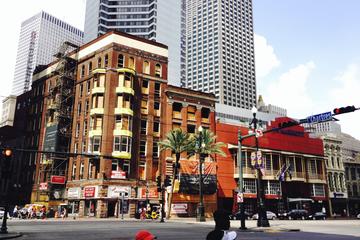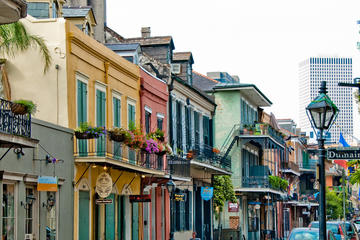
Reconnecting With The Past
by John Goodrow
Surrounding the banks of the Mississippi River are aspects of both the past and the present. Looking out into the river, the steamboats Creole Queen and Natchez take visitors from the French Quarter up the river and transport them into the distant past when the river was the highway of exploration. These steamboats use a paddle wheel to propel themselves along the river. Imagine a time in the past when similar ships steamed upstream loaded with bails of cotton and passengers of many types. You might meet a southern belle, or even a riverboat gambler. Jean-Baptiste Le Moyne de Bienville founded New Orleans in 1718. By 1860, the city had over 185 million dollars in commerce using the Mississippi River and a variety of ships from paddlewheel boats to flat-bottomed boats. The French Quarter exudes French and Spanish influences.
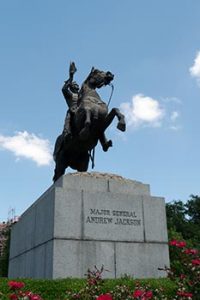 Walking inland from the river port, looking just ahead is an imposing figure of General Andrew Jackson on a reeling horse and surrounded by iron gated fences and palm trees with a backdrop of the three spires of Cathedral of St. Louis, King of France. The square was originally named Place d’Armes during the French period and Plaza de Armas during the Spanish period, or Weapons Square. This grassy plaza commonly known as Jackson Square (700 Decatur Street) is named for Andrew Jackson. He had a critical role in the history of the New Orleans.
Walking inland from the river port, looking just ahead is an imposing figure of General Andrew Jackson on a reeling horse and surrounded by iron gated fences and palm trees with a backdrop of the three spires of Cathedral of St. Louis, King of France. The square was originally named Place d’Armes during the French period and Plaza de Armas during the Spanish period, or Weapons Square. This grassy plaza commonly known as Jackson Square (700 Decatur Street) is named for Andrew Jackson. He had a critical role in the history of the New Orleans.
France controlled Louisiana from 1718 until 1763. At the end of the French and Indian War, Spain gained control but returned Louisiana to French rule in 1800. The raising of the American flag in 1803, in this square ended colonial rule in Louisiana. In the War of 1812 only nine years later, it fell upon General Andrew Jackson to prevent the British from capturing New Orleans. With only a small group of soldiers, militiamen, Indians, and a few pirates, he was able to defeat the powerful British army.
 Beyond the statue of Andrew Jackson are the trio of the Cabildo, Cathedral of St. Louis King of France, and the Presbytere. The Cabildo (700 Chartres Street) is a museum that commemorates the seat of colonial power under the Spanish. It was the center of municipal government in New Orleans until 1853. The final transfer of Louisiana to the United States occurred here. Do not miss this museum. It has many artifacts throughout the early history of Louisiana and has an exhibit on the third floor with more extensive coverage of New Orleans through the present time.
Beyond the statue of Andrew Jackson are the trio of the Cabildo, Cathedral of St. Louis King of France, and the Presbytere. The Cabildo (700 Chartres Street) is a museum that commemorates the seat of colonial power under the Spanish. It was the center of municipal government in New Orleans until 1853. The final transfer of Louisiana to the United States occurred here. Do not miss this museum. It has many artifacts throughout the early history of Louisiana and has an exhibit on the third floor with more extensive coverage of New Orleans through the present time.
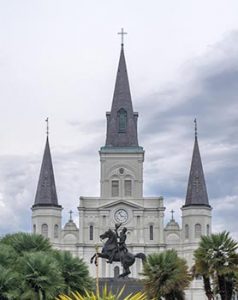 After leaving the Cabildo, enter the St. Louis Cathedral (615 Pere Antoine Alley). Towering above the surrounding buildings with its three steeples, it is the oldest active cathedral in the United States. The cathedral is the seat of the Roman Catholic Archdiocese of New Orleans. There have been three churches built on these grounds. The first church was built here in 1718 and designed by Adrien De Pauger during the initial period of French control.
After leaving the Cabildo, enter the St. Louis Cathedral (615 Pere Antoine Alley). Towering above the surrounding buildings with its three steeples, it is the oldest active cathedral in the United States. The cathedral is the seat of the Roman Catholic Archdiocese of New Orleans. There have been three churches built on these grounds. The first church was built here in 1718 and designed by Adrien De Pauger during the initial period of French control.
A significant portion of the French Quarter including the cathedral was destroyed by a massive fire in 1788. The Cathedral of St. Louis completed its reconstruction in 1794, during a period of Spanish colonial possession. During the construction of the new church, Louisiana and Florida were included as a diocese by Pope Pius VI with the new church as a cathedral with Luis Pefialver y Cardenas of Havana as its first bishop.
After Louisiana became part of the United States, the population of New Orleans grew rapidly. In the period of fewer than fifty years, the St. Louis Cathedral needed additional room leading to the construction of the third church in 1850. The enlargement required many improvements to the structural walls of the church. The reconstruction reused the bell tower, but nothing else. The church has many notable residents buried under its floors, including the designer Adrien De Pauger as well as members of the French clergy of colonial Louisiana.
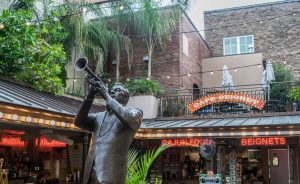 After all of your adventures reliving the past, enjoy some refreshments and entertainment. The French Quarter has plenty of places that will satisfy these requirements and is the oldest part of New Orleans. It was founded in 1718 and was known as Vieux Carré. The rest of the city developed around this area and received its current name as English-speaking residents arrived in New Orleans.
After all of your adventures reliving the past, enjoy some refreshments and entertainment. The French Quarter has plenty of places that will satisfy these requirements and is the oldest part of New Orleans. It was founded in 1718 and was known as Vieux Carré. The rest of the city developed around this area and received its current name as English-speaking residents arrived in New Orleans.
For a quick bite to eat and some light jazz head over to Music Legends Park (311 Bourbon Street). Their menu features everything ranging from beignets to sandwiches while jazz musicians play for your entertainment. You will have statues of music legends such as Irma Thomas, Fats Domino and Allen Toussaint welcoming you to the park.
As the afternoon gives way to early evening, head down to Pat O’Brien’s (718 St. Peter Street). This bar has been in business since before 1933 when it transitioned from being an illegal speakeasy to a legal drinking establishment.
The building that they use began its life as the French Theater Company in 1791. They introduced their signature hurricane drink during World War II. At the time, O’Brien’s had too much rum on hand but not enough whiskey, so they came up with an unusually bright red drink made of rum, fruit juice, and syrup. The drink gets its name from the shape of its glass container. The drink is usually served in a plastic glass, although you can get it in a hurricane glass for a nominal fee. The plastic glass makes it easy to carry your drink during your exploration of the French Quarter. It is legal in New Orleans to drink in public as long as you are not using a glass container. Their menu also offers a variety of other alcoholic and non-alcoholic beverages. The staff will serve you light food items ranging from sandwiches to soups and gumbo.
If You Go:
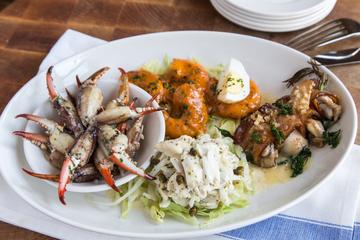
Taste of New Orleans Private Walking and Food Tour
The climate in the summer tends to be very humid, and an umbrella will help for both pop up showers and protection from the sun.
For history and general knowledge:
Visitors Center
Cabildo
Cathedral of St. Louis, King of France
Jackson Square
For dining and entertainment:
New Orleans Musical Legends Park
Pat O’Brien’s Bar
About the author:
John Goodrow is a seasoned traveler, having visited every continent except Antarctica during his career in the United States Navy. Currently living and working in Mississippi, he enjoys traveling to historic and lesser-known areas throughout the world. He shares his knowledge of early American and Military history through travel writing.
All photos by John Goodrow




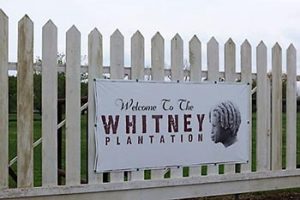
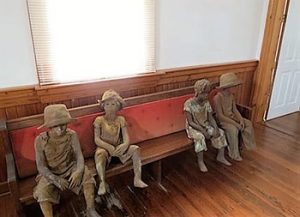

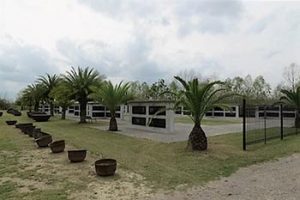
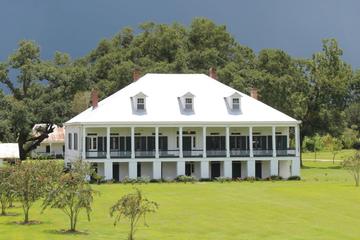

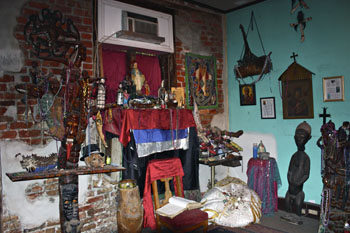
 Statues of saints seemed more out of place than the skeletons because this was no church. Then there were the voodoo dolls. Voodoo practitioners believe that voodoo dolls don’t just represent someone but actually become that person when a personal item such as a lock of hair or fingernails is added.
Statues of saints seemed more out of place than the skeletons because this was no church. Then there were the voodoo dolls. Voodoo practitioners believe that voodoo dolls don’t just represent someone but actually become that person when a personal item such as a lock of hair or fingernails is added.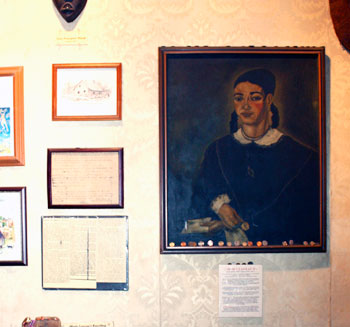 Our education continued when our tour guide reported that New Orleans voodoo is synonymous with voodoo queen Marie Laveau (1793-1882), whom he referred to as a free woman of color. NU’awlons pointed up at her picture on the wall as we left the museum to begin the walking tour. She was at the height of her power/influence in the 1850s. Although she was not psychic she had built up that reputation by collecting gossip when she visited various houses in the French Quarter to braid women’s hair.
Our education continued when our tour guide reported that New Orleans voodoo is synonymous with voodoo queen Marie Laveau (1793-1882), whom he referred to as a free woman of color. NU’awlons pointed up at her picture on the wall as we left the museum to begin the walking tour. She was at the height of her power/influence in the 1850s. Although she was not psychic she had built up that reputation by collecting gossip when she visited various houses in the French Quarter to braid women’s hair.
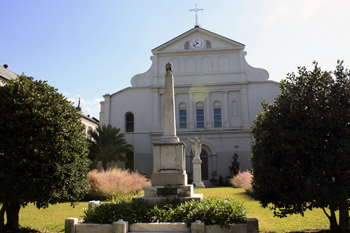 Our first stop was the St. Louis Cathedral but not to visit the interior. Instead we walked outside to the rear of the building where we found a small garden fenced off from the public. Peering through the wrought iron fence we saw a statue of Christ with raised arms. Marie Laveau was a member of this church congregation and she was known to perform voodoo rituals in this garden.
Our first stop was the St. Louis Cathedral but not to visit the interior. Instead we walked outside to the rear of the building where we found a small garden fenced off from the public. Peering through the wrought iron fence we saw a statue of Christ with raised arms. Marie Laveau was a member of this church congregation and she was known to perform voodoo rituals in this garden.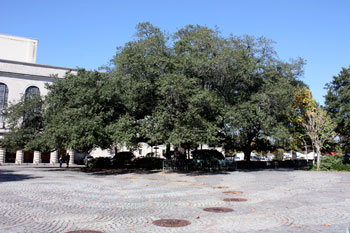 We crossed Basin Street and entered the neighborhood of Treme to visit Congo Square in Louis Armstrong Park. Creole slave owners strictly enforced the practice of Catholicism but the slaves circumvented this by gathering at Congo Square each Sunday (their one day off during the week under the Code Noire) to sing and gyrate to the rhythm of drum beats. They also participated in voodoo rituals.
We crossed Basin Street and entered the neighborhood of Treme to visit Congo Square in Louis Armstrong Park. Creole slave owners strictly enforced the practice of Catholicism but the slaves circumvented this by gathering at Congo Square each Sunday (their one day off during the week under the Code Noire) to sing and gyrate to the rhythm of drum beats. They also participated in voodoo rituals.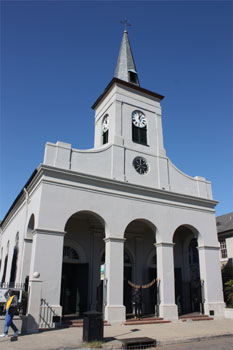 After you find your inner beat, leave Congo Square and visit the nearby Our Lady of Guadalupe Chapel. This church boasts a number of local voodoo practitioners among its congregation but you likely will not be able to identify them because they look just like anybody else.
After you find your inner beat, leave Congo Square and visit the nearby Our Lady of Guadalupe Chapel. This church boasts a number of local voodoo practitioners among its congregation but you likely will not be able to identify them because they look just like anybody else.
 Exit the Chapel and proceed to St. Louis Cemetery #1. The living is admitted free but the families of the dead must pay to maintain the upkeep of all the above-ground tombs that surround you. The French had a custom of interring people above ground because they did not want to have buried coffins rising to the surface and falling open because of the high water table and flooding for which the Crescent City is famous. With a little imagination you have the making of a good horror movie where the zombies rise from the open coffins in search of the living.
Exit the Chapel and proceed to St. Louis Cemetery #1. The living is admitted free but the families of the dead must pay to maintain the upkeep of all the above-ground tombs that surround you. The French had a custom of interring people above ground because they did not want to have buried coffins rising to the surface and falling open because of the high water table and flooding for which the Crescent City is famous. With a little imagination you have the making of a good horror movie where the zombies rise from the open coffins in search of the living.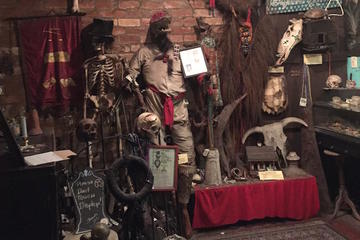

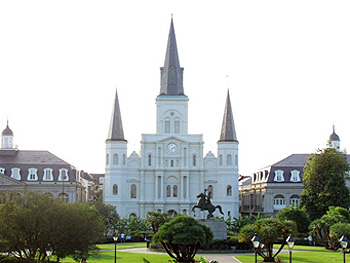
 New Orleans is known for many other things: seafood, e.g. crawfish, shrimp, crab and also for its music and musicians. The New Orleans area has the most home grown musicians in the country. They run the gamut from rock and roll, blues, jazz and even classical, from Fats Domino and Professor Longhair to Louie Prima and Louie Armstrong. However if New Orleans is known for anything it is a slogan and an attitude of, “Laissez les bons temps rouler, let the good times roll.” And that’s the truth! Ask any native New Orleanian.
New Orleans is known for many other things: seafood, e.g. crawfish, shrimp, crab and also for its music and musicians. The New Orleans area has the most home grown musicians in the country. They run the gamut from rock and roll, blues, jazz and even classical, from Fats Domino and Professor Longhair to Louie Prima and Louie Armstrong. However if New Orleans is known for anything it is a slogan and an attitude of, “Laissez les bons temps rouler, let the good times roll.” And that’s the truth! Ask any native New Orleanian. My wife and I visited the city of Slidell and our old neighborhood, New Orleans East and Downtown New Orleans. We had resided in Slidell, Louisiana located about 20 miles northeast of New Orleans from 1978-1984. We lived through two floods and two hurricanes, luckily none of which caused us any major problems, because we had boarded up the windows and battened down everything. The second hurricane was more severe than the first one and we did not get to sleep as the sound of the winds emanating from the storm kept us awake. They were howling at over 110 mph and sounded like a locomotive as the hurricane passed over us.
My wife and I visited the city of Slidell and our old neighborhood, New Orleans East and Downtown New Orleans. We had resided in Slidell, Louisiana located about 20 miles northeast of New Orleans from 1978-1984. We lived through two floods and two hurricanes, luckily none of which caused us any major problems, because we had boarded up the windows and battened down everything. The second hurricane was more severe than the first one and we did not get to sleep as the sound of the winds emanating from the storm kept us awake. They were howling at over 110 mph and sounded like a locomotive as the hurricane passed over us. The Slidell Memorial Hospital on Gause Blvd expanded in January 2011 with the opening of the Regional Cancer Center on Robert Blvd. Slidell has prospered since our last visit. There are many new commercial and business establishments. Some old ones are gone and new ones have taken their place.
The Slidell Memorial Hospital on Gause Blvd expanded in January 2011 with the opening of the Regional Cancer Center on Robert Blvd. Slidell has prospered since our last visit. There are many new commercial and business establishments. Some old ones are gone and new ones have taken their place. We drove through our old neighborhood which seems the less for wear. Talking with old friends and some of our old neighbors we learn that our old subdivision along Interstate 12 was spared the wrath of Katrina. There are new stores, gas stations and Brownswitch road one of the main routes now has a turnabout at Robert Road reflecting the growth in traffic patterns. Ah, progress.
We drove through our old neighborhood which seems the less for wear. Talking with old friends and some of our old neighbors we learn that our old subdivision along Interstate 12 was spared the wrath of Katrina. There are new stores, gas stations and Brownswitch road one of the main routes now has a turnabout at Robert Road reflecting the growth in traffic patterns. Ah, progress. New Orleans East & Metairie was hard hit by water. We drove down Read Blvd through the area where once stood the Lake Forest Mall in New Orleans East. The huge complex is gone, and a building on the Interstate 10 frontage road where I where I was employed for a time is now four walls and gutted. You can see through it, some of the windows are broken. I also remember a restaurant down the street, a Denny’s I believe. It is now gone. Katrina did it all.
New Orleans East & Metairie was hard hit by water. We drove down Read Blvd through the area where once stood the Lake Forest Mall in New Orleans East. The huge complex is gone, and a building on the Interstate 10 frontage road where I where I was employed for a time is now four walls and gutted. You can see through it, some of the windows are broken. I also remember a restaurant down the street, a Denny’s I believe. It is now gone. Katrina did it all. Play tourist and enjoy the ambiance of what New Orleans has to offer. There is a different feeling about visiting downtown New Orleans as a tourist compared to living there and visiting. Stop at historic Jackson Square and enjoy. It was originally known in the 18th century as “Place d’Armes,” and later renamed in honor of the hero of the Battle of New Orleans, Andrew Jackson. It is a timeless attraction in the heart of the French Quarter of New Orleans. There is a different view, tourists are everywhere, we walk through the cobbled streets and stop and listen to a jam session featuring a group of Jazz musicians performing, “When the Saints Go Marching In.” Canal Street is still vibrant and St Louis Cathedral is peaceful. We visit Harrah’s Casino to try our luck. We pass by a familiar face, the Superdome still intact, looking like a gigantic flying saucer. It is good to see some of our old memories.
Play tourist and enjoy the ambiance of what New Orleans has to offer. There is a different feeling about visiting downtown New Orleans as a tourist compared to living there and visiting. Stop at historic Jackson Square and enjoy. It was originally known in the 18th century as “Place d’Armes,” and later renamed in honor of the hero of the Battle of New Orleans, Andrew Jackson. It is a timeless attraction in the heart of the French Quarter of New Orleans. There is a different view, tourists are everywhere, we walk through the cobbled streets and stop and listen to a jam session featuring a group of Jazz musicians performing, “When the Saints Go Marching In.” Canal Street is still vibrant and St Louis Cathedral is peaceful. We visit Harrah’s Casino to try our luck. We pass by a familiar face, the Superdome still intact, looking like a gigantic flying saucer. It is good to see some of our old memories.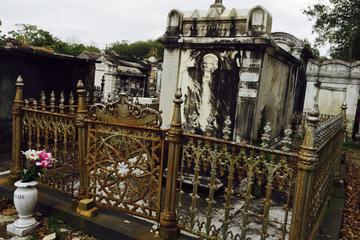

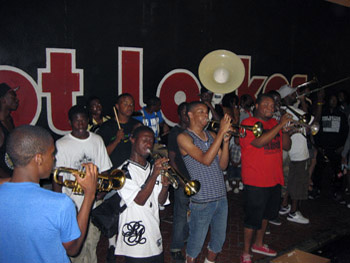 The French Quarter Festival is a free annual music festival located in the historic French Quarter of New Orleans, Louisiana, first held in 1984. It features traditional and contemporary jazz, R&B, New Orleans funk, brass bands, folk, gospel, Latin, Cajun and zydeco played by Louisiana residents. There was an estimated attendance when we attended in 2012 of over 574,000, and over 732,000 for the 20th annual festival in 2014. The French Quarter Festival is funded solely from donations, sponsorships and grants. It is the largest free festival in North America.
The French Quarter Festival is a free annual music festival located in the historic French Quarter of New Orleans, Louisiana, first held in 1984. It features traditional and contemporary jazz, R&B, New Orleans funk, brass bands, folk, gospel, Latin, Cajun and zydeco played by Louisiana residents. There was an estimated attendance when we attended in 2012 of over 574,000, and over 732,000 for the 20th annual festival in 2014. The French Quarter Festival is funded solely from donations, sponsorships and grants. It is the largest free festival in North America.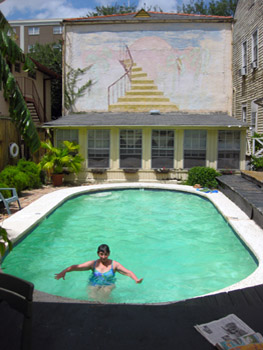 The French Quarter is the oldest neighborhood in New Orleans, founded in 1718. The area includes all the land stretching along the Mississippi River from Canal Street to Esplanade Avenue, and inland to North Rampart Street, an area of 78 square blocks. The district has been designated as a National Historic Landmark.
The French Quarter is the oldest neighborhood in New Orleans, founded in 1718. The area includes all the land stretching along the Mississippi River from Canal Street to Esplanade Avenue, and inland to North Rampart Street, an area of 78 square blocks. The district has been designated as a National Historic Landmark.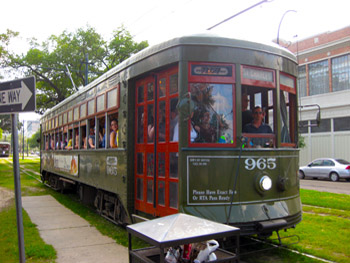 As you would expect with a festival of this size, rooms are at a premium during the festival. There are many accommodations in the Quarter itself, but we feared that it would be too noisy to sleep there. We opted for a small hotel in the nearby Garden District called the St. Charles Guest House. A great example of NOLA faded glory, it featured air conditioning, a lovely pool, antique furnishings and very friendly and helpful staff. Just two blocks away was the famed St. Charles Trolley Line, the oldest continuously operating streetcar line in the world. The totally restored vintage streetcars were magnificent to look at. The fare was $1 (now $1.25), and the cars were jam-packed morning, noon and night during the festival. Despite this, one seldom had to wait very long for a ride.
As you would expect with a festival of this size, rooms are at a premium during the festival. There are many accommodations in the Quarter itself, but we feared that it would be too noisy to sleep there. We opted for a small hotel in the nearby Garden District called the St. Charles Guest House. A great example of NOLA faded glory, it featured air conditioning, a lovely pool, antique furnishings and very friendly and helpful staff. Just two blocks away was the famed St. Charles Trolley Line, the oldest continuously operating streetcar line in the world. The totally restored vintage streetcars were magnificent to look at. The fare was $1 (now $1.25), and the cars were jam-packed morning, noon and night during the festival. Despite this, one seldom had to wait very long for a ride.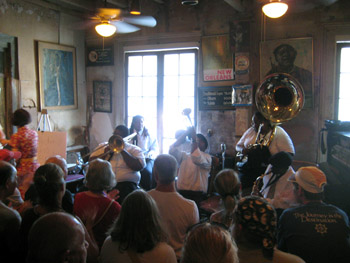 Of course, fascinated as we were by the architecture and the culture, we had come to see and hear the music. Friends who had been before us advised that it was a “great little festival”. We could only assume that they were comparing it to the massive New Orleans Jazz and Heritage Festival, since half a million attendees over four days made it much bigger than any other outdoor event we had ever attended. The total of 21 stages, many of them as large as the largest festival main stage we had ever seen, was a bit mind-boggling.
Of course, fascinated as we were by the architecture and the culture, we had come to see and hear the music. Friends who had been before us advised that it was a “great little festival”. We could only assume that they were comparing it to the massive New Orleans Jazz and Heritage Festival, since half a million attendees over four days made it much bigger than any other outdoor event we had ever attended. The total of 21 stages, many of them as large as the largest festival main stage we had ever seen, was a bit mind-boggling.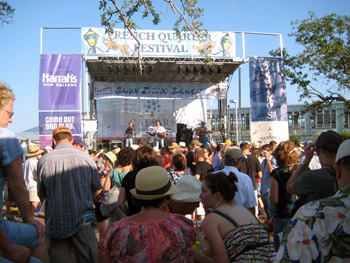 There was a lot to see and hear in evenings, after the festival activities wound down, in what is probably the most musical of all cities in North America. We went to a Cajun Fais Do Do with Bruce Daigrepont at Tipitina’s uptown, a regular feature of the club. Several friends told us that we absolutely had to go see Charmaine Neville at Snug Cove, where she had been entertaining for many years. This was about the only real disappointment of our trip – she was much too self-indulgent and tourist-pandering for our liking.
There was a lot to see and hear in evenings, after the festival activities wound down, in what is probably the most musical of all cities in North America. We went to a Cajun Fais Do Do with Bruce Daigrepont at Tipitina’s uptown, a regular feature of the club. Several friends told us that we absolutely had to go see Charmaine Neville at Snug Cove, where she had been entertaining for many years. This was about the only real disappointment of our trip – she was much too self-indulgent and tourist-pandering for our liking.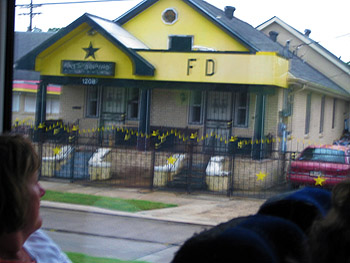 Aside from being unprepared for the enormity of the festival, the other thing that was a bit of a surprise was the temperature. Mid-April in Vancouver is still quite moderate. We knew that it would be a bit toastier in the Deep South, but were still surprised to be greeted by the high humidity and mid-nineties temperatures (about 35 degrees Celsius). We slowly came to the realization that we just couldn’t take tramping around in the heat all day every day, so we decided on a couple of other activities.
Aside from being unprepared for the enormity of the festival, the other thing that was a bit of a surprise was the temperature. Mid-April in Vancouver is still quite moderate. We knew that it would be a bit toastier in the Deep South, but were still surprised to be greeted by the high humidity and mid-nineties temperatures (about 35 degrees Celsius). We slowly came to the realization that we just couldn’t take tramping around in the heat all day every day, so we decided on a couple of other activities.
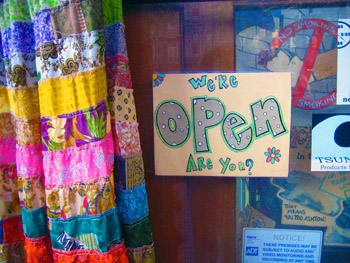 I have been inexplicably drawn to its music and culture of New Orleans for most of my adult life. It’s a fascinating city, full of contradictions such as the enthusiastic celebrations of God and Satan that surround you all the time.
I have been inexplicably drawn to its music and culture of New Orleans for most of my adult life. It’s a fascinating city, full of contradictions such as the enthusiastic celebrations of God and Satan that surround you all the time.